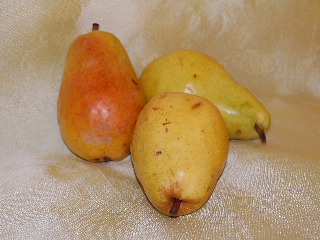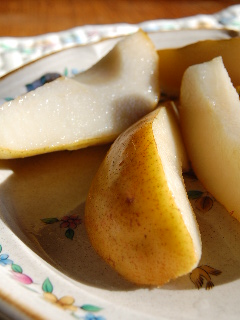
Over the years, the humble pear has found a place of prominence in both the visual arts and the culinary arts.
Who has not seen a still life painting of a bowl of fruit, featuring the softly colored yellow, pink, and green hues of ripe pears nestled among other fruits and vegetables? Even the expression “pear-shaped” is used in art classes to identify the outline of various inanimate objects as well as being a descriptive term in human anatomy.
And for the artist whose studio is the kitchen, the pear represents a reliable element to integrate into the dining table palette, whether used in its simplest form as a raw fruit mixed into a fresh salad; or served, baked and glazed, as a more elegant side dish for broiled salmon.
The pear also plays a starring role in the nutrition lineup, too. Pears are a good source of fiber, being rich in pectin which is a soluble fiber that helps the body eliminate cholesterol. A medium-sized pear contains about 6 grams of fiber, which represents about 24% of the RDA (recommended daily allowance) for fiber in a healthy diet. High fiber diets have been shown to reduce the risk of heart disease and certain types of cancer.
Pears are a good source of healthy carbohydrates, being slow to convert to sugar and enter into the bloodstream. They are also a good source of Vitamins A, C, E, and K, as well as potassium and copper.
Vitamin C helps to bolster the immune system by stimulating white blood cells to fight infection; it also helps kill bacteria and viruses in the body.
Vitamin K is believed to be helpful in preventing and treating osteoporosis and loss of bone density, ailments often commonly associated with aging. Vitamin K is also beneficial to the body as an aid in blood clotting.
The copper in pears helps protect the body from free radical damage.

Fresh pears are the perfect food to incorporate into your diet, whether you are seeking to lose weight or just maintain a healthy body through good nutrition. A medium pear contains less than 100 calories, helps lower cholesterol, and best of all—just plain tastes good!
If you buy your pears fresh at the market, look for ones that are not already overly ripe and spotted with dark blemishes. Select pears that are still firm to the touch, bring them home and let them ripen at room temperature; if they start to get too ripe, they may be kept in the refrigerator for a few days. Unfortunately, pears have a rather short “shelf-life” once they ripen and need to be consumed before they become unusable.
One way to be assured of good quality fresh pears is to grow your own! If you have room in your home landscape to incorporate fruit trees into the plan, why not consider planting a couple of pear trees? Pear trees tend to be quite hardy, especially if you start with good quality planting stock from a reliable source (such as Stark Brothers, etc.).
Bartlett pear trees are probably the most popular and widely planted of the old established varieties. They produce big yellow pears that are juicy and delicious, perfect for eating fresh or canning. One possible drawback to the Bartletts is that the trees grow to quite a large size, which may be a negative if you have rather limited space in your landscape. Think, instead, of some of the dwarf or semi-dwarf varieties.
Give your pear trees sunshine, adequate moisture, and a rich well-drained soil. With minimal pruning and maintenance, they should begin to bear fruit in just a year or two.
Consider yourself fortunate to have added a classic to your landscape and to your diet!
 Over the years, the humble pear has found a place of prominence in both the visual arts and the culinary arts.
Over the years, the humble pear has found a place of prominence in both the visual arts and the culinary arts.
 Fresh pears are the perfect food to incorporate into your diet, whether you are seeking to lose weight or just maintain a healthy body through good nutrition. A medium pear contains less than 100 calories, helps lower cholesterol, and best of all—just plain tastes good!
Fresh pears are the perfect food to incorporate into your diet, whether you are seeking to lose weight or just maintain a healthy body through good nutrition. A medium pear contains less than 100 calories, helps lower cholesterol, and best of all—just plain tastes good!